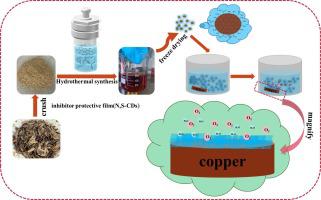当前位置:
X-MOL 学术
›
J. Ind. Eng. Chem.
›
论文详情
Our official English website, www.x-mol.net, welcomes your feedback! (Note: you will need to create a separate account there.)
Melon seed shell synthesis N, S-carbon quantum dots as ultra-high performance corrosion inhibitors for copper in 0.5 M H2SO4
Journal of Industrial and Engineering Chemistry ( IF 6.1 ) Pub Date : 2024-04-16 , DOI: 10.1016/j.jiec.2024.04.019 Yan Liu , Haiqin Ren , Zhili Gong , Bochuan Tan , Wei Lan , Qingwei Dai , Xingwen Zheng , Lei Guo , Abeer A. AlObaid , Ismail Warad
Journal of Industrial and Engineering Chemistry ( IF 6.1 ) Pub Date : 2024-04-16 , DOI: 10.1016/j.jiec.2024.04.019 Yan Liu , Haiqin Ren , Zhili Gong , Bochuan Tan , Wei Lan , Qingwei Dai , Xingwen Zheng , Lei Guo , Abeer A. AlObaid , Ismail Warad

|
This work reports on the preparation of N, S-CQDs from melon seed shell, a common household waste that can inhibit the corrosion of copper in a 0.5 M HSO solution. Additionally, by varying the preparation time and preparation temperature, the effects of N, S-CQDs on the capacity of copper to resist corrosion in 0.5 M HSO solution were compared. It was also used to prove its inhibitory effect on copper in 0.5 M HSO solution by a series of test methods. The corrosion inhibition rate of N, S-CQDs was 99.66 % and 99.87 % when the N, S-CQDs prepared at 160 ℃ for 6 h and 200 ℃ for 10 h were added. The results indicate that the corrosion inhibition rate of N, S-CQDs increases with increasing preparation time and temperature. XPS (X-ray photoelectron spectroscopy) and ATR-FTIR (Fourier transform infrared) were used to describe the composition and functional groups adsorbed on the surface of copper. N, S-CQDs' corrosion inhibition property was demonstrated by using an AFM (Atomic force microscope) and SEM (Scanning electron microscopy) to examine the corrosion surface morphology. Using the Langmuir adsorption model, it was found that the corrosion of copper was inhibited by both physical and chemical adsorption. A number of experimental findings demonstrate that preparation temperature and time impact the degree of carbonization, size, and functional group content of the N, S-CQDs, which in turn influences the corrosion inhibition of the N, S-CQDs. By means of heteroatom adsorption and surface structure, N, S-CQDs generate new chemical coordination bonds on the copper surface, thereby forming a protective layer, reducing the interaction between copper and 0.5 M HSO solution, and generating a corrosion inhibition effect.
中文翻译:

瓜子壳合成N、S-碳量子点作为铜在0.5 M H2SO4中的超高性能缓蚀剂
这项工作报告了从瓜子壳(一种常见的生活垃圾)中制备 N,S-CQD,可以抑制铜在 0.5 M HSO 溶液中的腐蚀。此外,通过改变制备时间和制备温度,比较了N、S-CQDs对铜在0.5 M HSO溶液中耐腐蚀能力的影响。并通过一系列测试方法证明了其在0.5 M HSO溶液中对铜的抑制作用。添加160℃处理6 h和200℃处理10 h制备的N、S-CQDs时,缓蚀率分别为99.66%和99.87%。结果表明,N,S-CQDs的缓蚀率随着制备时间和温度的增加而增加。采用XPS(X射线光电子能谱)和ATR-FTIR(傅里叶变换红外)来描述铜表面吸附的组成和官能团。通过使用AFM(原子力显微镜)和SEM(扫描电子显微镜)检查腐蚀表面形貌,证明了N,S-CQDs的缓蚀性能。利用Langmuir吸附模型发现,物理和化学吸附均能抑制铜的腐蚀。大量实验结果表明,制备温度和时间会影响N,S-CQDs的碳化程度、尺寸和官能团含量,进而影响N,S-CQDs的缓蚀性能。 N,S-CQDs通过杂原子吸附和表面结构,在铜表面生成新的化学配位键,从而形成保护层,减少铜与0.5 M HSO溶液之间的相互作用,产生缓蚀作用。
更新日期:2024-04-16
中文翻译:

瓜子壳合成N、S-碳量子点作为铜在0.5 M H2SO4中的超高性能缓蚀剂
这项工作报告了从瓜子壳(一种常见的生活垃圾)中制备 N,S-CQD,可以抑制铜在 0.5 M HSO 溶液中的腐蚀。此外,通过改变制备时间和制备温度,比较了N、S-CQDs对铜在0.5 M HSO溶液中耐腐蚀能力的影响。并通过一系列测试方法证明了其在0.5 M HSO溶液中对铜的抑制作用。添加160℃处理6 h和200℃处理10 h制备的N、S-CQDs时,缓蚀率分别为99.66%和99.87%。结果表明,N,S-CQDs的缓蚀率随着制备时间和温度的增加而增加。采用XPS(X射线光电子能谱)和ATR-FTIR(傅里叶变换红外)来描述铜表面吸附的组成和官能团。通过使用AFM(原子力显微镜)和SEM(扫描电子显微镜)检查腐蚀表面形貌,证明了N,S-CQDs的缓蚀性能。利用Langmuir吸附模型发现,物理和化学吸附均能抑制铜的腐蚀。大量实验结果表明,制备温度和时间会影响N,S-CQDs的碳化程度、尺寸和官能团含量,进而影响N,S-CQDs的缓蚀性能。 N,S-CQDs通过杂原子吸附和表面结构,在铜表面生成新的化学配位键,从而形成保护层,减少铜与0.5 M HSO溶液之间的相互作用,产生缓蚀作用。



























 京公网安备 11010802027423号
京公网安备 11010802027423号